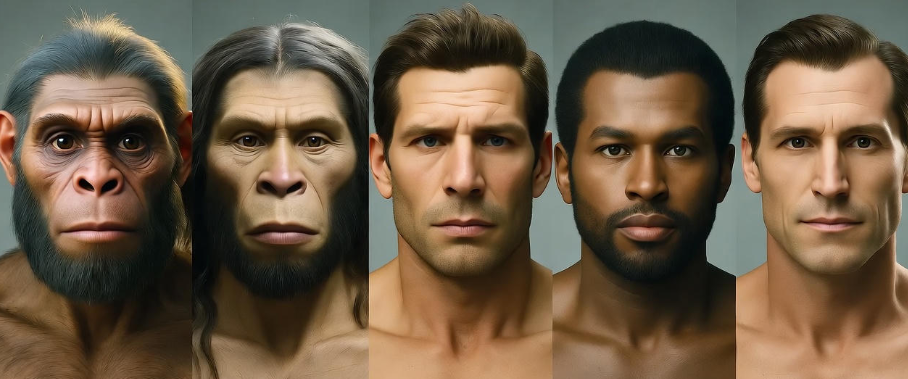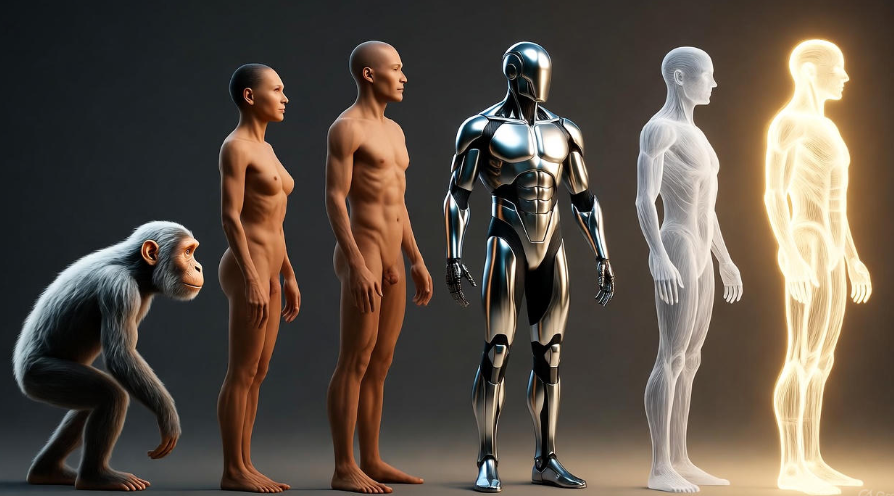Have you ever wondered how we became who we are today? 🧠 Humans didn’t just appear overnight — we’re the result of millions of years of evolution, shaped by nature, survival, and curiosity. The story of human evolution is like a long journey — from small, ape-like creatures to the complex beings that build rockets, write poetry, and create smartphones. Let’s walk through this fascinating journey together in a simple, easy-to-understand way.
The Beginning: Early Primates 🌳
About 60 million years ago, the first primates appeared. These were small, tree-dwelling creatures — our very distant relatives. They weren’t humans, but they had some features that would eventually lead to us. They could grasp branches with their hands and had good vision, which helped them survive in forests.
Primates are important because they show the earliest signs of intelligence and adaptation. They learned how to use their surroundings, move quickly, and protect themselves from predators. Over millions of years, some of these primates started walking more upright and exploring new environments — a small step toward becoming human.
| Early Primates | Key Traits |
|---|---|
| Tree-dwelling mammals | Strong grip, flexible hands |
| Lived 60 million years ago | Developed depth perception |
| Ate fruits and insects | High brain-to-body ratio |
Australopithecus – The First Walkers 🚶♀️
Around 4 to 2 million years ago, a species called Australopithecus appeared in Africa. These early humans were the first to walk upright on two legs. Imagine a creature that looked part human and part ape — that’s them.
Their ability to walk on two feet changed everything. It freed their hands, allowing them to use tools and carry food. They also began living in groups, which helped them stay safe. Scientists believe this was the first big step in human evolution — literally and figuratively.
Fun fact: “Lucy,” one of the most famous fossils ever found, was an Australopithecus afarensis. She lived around 3.2 million years ago and gave us a clear picture of how our ancestors looked and moved.
Homo habilis – The Handy Man 🪓
Next came Homo habilis, about 2.4 million years ago. The name actually means “handy man” because this was the first species to make and use stone tools. They chipped rocks to cut meat, smash bones, and build shelters — a major leap in survival skills.
They also had larger brains than Australopithecus, suggesting the beginning of problem-solving and planning. It’s believed they lived in simple social groups and shared food, which made cooperation a key part of survival.
| Homo habilis | Highlights |
|---|---|
| Time period | 2.4 – 1.4 million years ago |
| Major skill | Used stone tools |
| Brain size | About half of modern human’s brain |
| Location | Africa |
This was the stage where intelligence began to take shape. You could say Homo habilis lit the first spark of human creativity. 🔥
Homo erectus – The Traveler and Fire-Master 🌍🔥
Then came Homo erectus — literally “upright man.” They appeared about 1.9 million years ago and marked another major step forward. Homo erectus was the first species to leave Africa, spreading into Asia and Europe.
They didn’t just walk far — they also learned to control fire. That might sound small, but it changed everything. Fire meant warmth, safety, and cooked food, which made digestion easier and supported brain growth.
They built simple tools, hunted animals, and probably had a basic form of communication. Many scientists believe Homo erectus lived for nearly two million years, making them one of the most successful human ancestors ever.
Homo neanderthalensis – The Ice Age Survivors ❄️
Next came the Neanderthals — tough, strong, and intelligent humans who lived in Europe and western Asia about 400,000 to 40,000 years ago. They adapted to freezing Ice Age conditions, built shelters, used fire, and even buried their dead — a sign of emotional intelligence.
Neanderthals were not just brute hunters. They made clothing, created tools, and probably had language. For a long time, they lived alongside early modern humans (Homo sapiens). In fact, DNA studies show that most of us still carry 1–2% of Neanderthal genes, meaning there was some interbreeding between them and our ancestors.
| Neanderthals | Traits |
|---|---|
| Time Period | 400,000 – 40,000 years ago |
| Habitat | Cold climates of Europe and Asia |
| Key Skill | Fire use, tool-making, hunting |
| Unique Behavior | Burial rituals, emotional bonds |
Their extinction remains a mystery — climate change, diseases, or competition with modern humans may have played a part. But their story lives within us, quite literally.
Homo sapiens – The Wise Humans 🧠
Finally, about 300,000 years ago, modern humans (Homo sapiens) appeared in Africa. That’s us — the thinkers, dreamers, and creators. We had larger brains, complex languages, and a deep ability to imagine and plan ahead.
Our ancestors began painting on cave walls, crafting jewelry, and forming social groups. They migrated across continents, invented tools, and learned to farm around 10,000 years ago, starting the agricultural revolution.
This was the era when humans began shaping the planet — creating civilizations, art, and technology. From building the pyramids to exploring space, every achievement connects back to this evolutionary success story.
The Future of Evolution 🤖
You might think evolution stopped with us — but it hasn’t. Human evolution continues, though in different ways. Modern medicine, technology, and environment still shape our genes. Future humans might have stronger immune systems, adaptations to climate, or even integrated AI technology.
It’s an exciting, mysterious road ahead — just as it’s been for millions of years.
Quick Summary Table 🧩
| Evolution Stage | Time Period | Key Development | Importance |
|---|---|---|---|
| Early Primates | ~60 million years ago | Tree-dwelling animals | Foundation of human traits |
| Australopithecus | 4–2 million years ago | Walked upright | Freed hands for tools |
| Homo habilis | 2.4–1.4 million years ago | Used tools | Early intelligence |
| Homo erectus | 1.9 million years ago | Fire use, migration | Adaptation and travel |
| Neanderthals | 400k–40k years ago | Social life, rituals | Emotional and cultural growth |
| Homo sapiens | 300k years ago – present | Complex language | Modern civilization |
| Future Humans | Ongoing | Genetic and tech changes | Future adaptation |

Interesting Facts About Human Evolution 🧬
-
We share 98.8% of our DNA with chimpanzees!
-
The human brain has tripled in size over 3 million years.
-
Fire cooking may have helped brains grow faster.
-
Our ancestors’ jawbones became smaller as tools replaced chewing tough food.
-
The first humans in Africa had dark skin — lighter tones evolved later in colder climates.
Why Understanding Evolution Matters
Knowing where we come from helps us understand who we are. Evolution tells a story of survival, cooperation, and endless curiosity. It reminds us that every human being — no matter where they live — shares the same ancient roots. 🌍
It also teaches us humility. The journey wasn’t instant; it took millions of years of trial and error. Yet, here we are — the result of nature’s finest experiment in intelligence.
FAQs About Human Evolution
Q1: Did humans evolve from monkeys?
Not exactly. Humans and monkeys share a common ancestor, but we took different evolutionary paths millions of years ago.
Q2: How do scientists know all this?
Through fossils, DNA studies, and archaeological discoveries. Each fossil tells part of the story — like puzzle pieces from ancient history.
Q3: Are we still evolving today?
Yes! Evolution never stops. Changes in diet, environment, and technology continue to shape our biology slowly.
Q4: What’s the most important step in evolution?
Probably walking upright and using fire — both changed how humans lived, ate, and survived.
Q5: Could humans evolve into a new species?
Possibly. If humans live in different environments (like space colonies someday 🌌), separate evolution paths could begin again.
Final Thoughts 💡
Human evolution is not just a story of biology — it’s a story of courage, intelligence, and adaptability. From walking in the wilds of Africa to walking on the Moon, our journey shows how small changes can lead to incredible progress.
Every human alive today carries the history of evolution in their DNA — a living reminder that we are all connected through time. 🌍✨

Leave a Reply